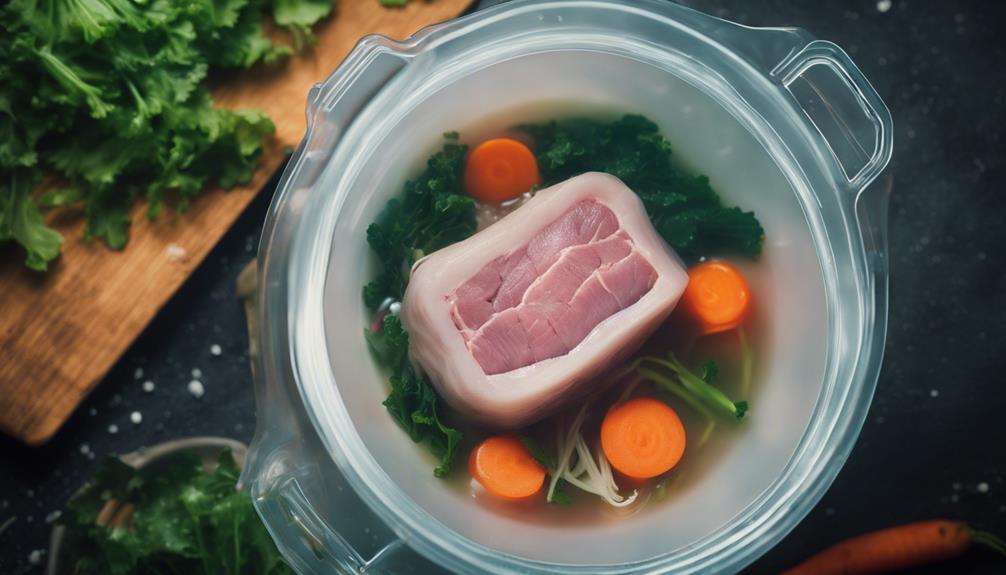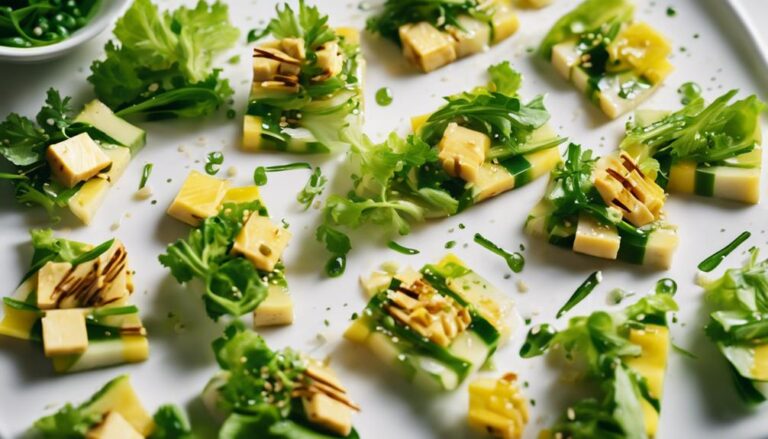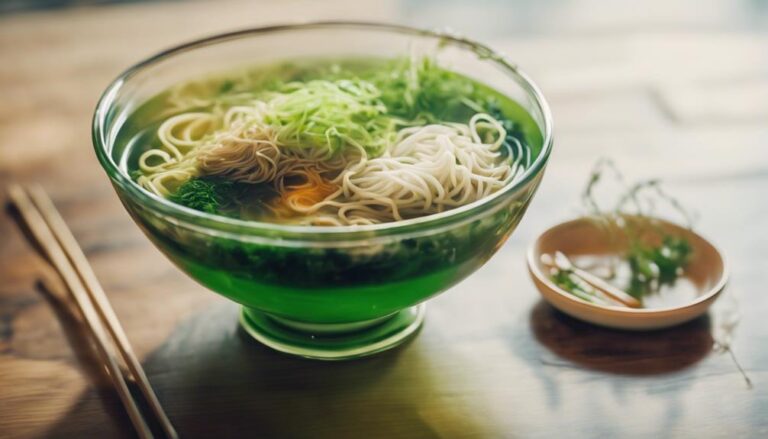Sous Vide Okinawa Tonjiru (Pork and Vegetable Soup)
Imagine this: succulent pork, colorful veggies, and a symphony of flavors dancing in your bowl. This dish packs a punch of umami goodness and heartwarming vibes. The secret? Slow cooking the ingredients in a water bath to tender perfection. Envision diving into a delicious adventure of vibrant Okinawan cuisine that reflects the island's rich history. This soup is not just a meal; it's an experience that will make your taste buds sing with delight. Ready to elevate your culinary game? Get ready for a flavor rollercoaster!
What You Will Learn Here
- Sous vide method ensures precise cooking temperatures for tender pork.
- Tonjiru is a hearty pork and vegetable soup from Okinawan cuisine.
- Rich umami flavors develop slowly in the sous vide process.
- Vegetables retain nutrients and flavors in the sealed sous vide environment.
- Sous vide Tonjiru results in a deeply flavorful and comforting dish.
Traditional Okinawan Culinary Roots
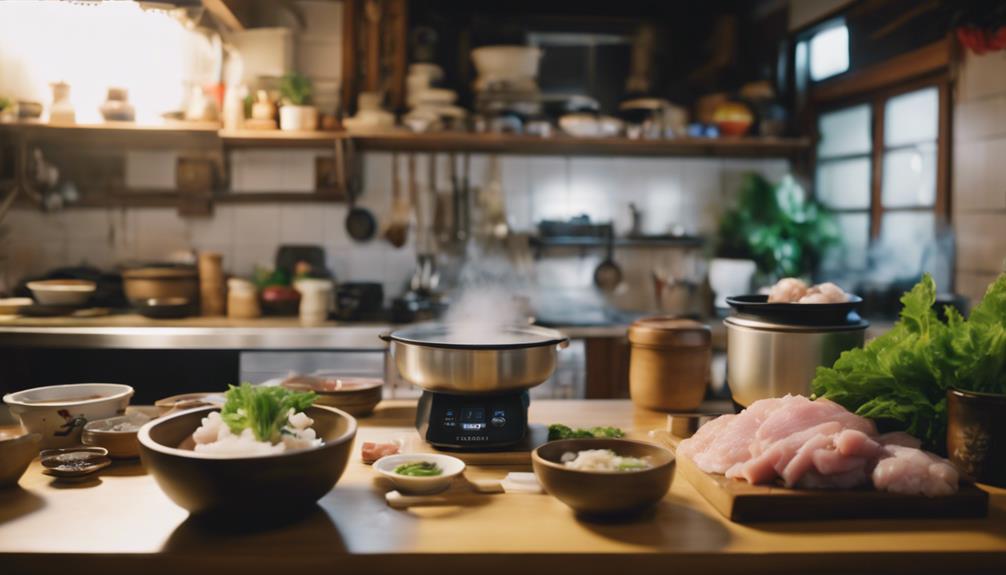
So, you're about to begin a flavorful journey through the roots of Okinawan cuisine.
Let's talk about the rich tapestry of Okinawan culinary heritage, the diverse influences that have shaped its unique flavors, and the traditional ingredients that make dishes from this region truly special.
Get ready to explore the delicious world of Okinawan cooking!
Okinawan Culinary Heritage
Exploring the traditional culinary roots of Okinawa reveals a rich tapestry of flavors and techniques unique to the region. Okinawan culinary techniques are like secret recipes passed down through generations, each dish holding a story of the island's history.
From the comforting flavors of Rafute (braised pork belly) to the vibrant hues of Goya Champuru (bitter melon stir-fry), Okinawan cuisine is a delightful blend of tradition and innovation. The island's dishes often feature ingredients like purple sweet potatoes, seaweed, and pork—reflecting its diverse cultural influences.
Traditional Okinawan dishes not only tantalize the taste buds but also offer a glimpse into the soul of the island, where each bite tells a tale of resilience and community spirit.
Influences on Okinawa Cuisine
The diverse cultural influences on Okinawan cuisine have shaped a culinary heritage rich in unique flavors and techniques.
Okinawa's culinary scene is like a delicious melting pot, blending traditional Ryukyuan dishes with fusion flavors from various cultures.
Over the years, Okinawan cuisine has undergone fascinating cultural adaptations, incorporating elements from Chinese, Japanese, and Southeast Asian cooking styles.
These influences have added layers of complexity to Okinawan dishes, creating a tapestry of flavors that dance on your taste buds.
From stir-fried dishes to savory soups, each bite tells a story of the island's history and the people who've made it their home.
Traditional Okinawan Ingredients
What traditional ingredients form the culinary roots of Okinawan cuisine?
Well, let's take a flavorful exploration into the traditional ingredients that make Okinawan dishes so unique! Culinary traditions in Okinawa are a delightful mix of influences from China, Japan, and Southeast Asia. The key to these mouthwatering dishes lies in the use of traditional ingredients like bitter melon, purple sweet potatoes, sea grapes, and pork belly.
These ingredients not only add a burst of flavor but also bring a touch of Okinawan culture to the table. Imagine the sweet aroma of purple sweet potatoes mingling with the savory goodness of pork belly – a match made in culinary heaven!
Okinawan Sweet Potatoes
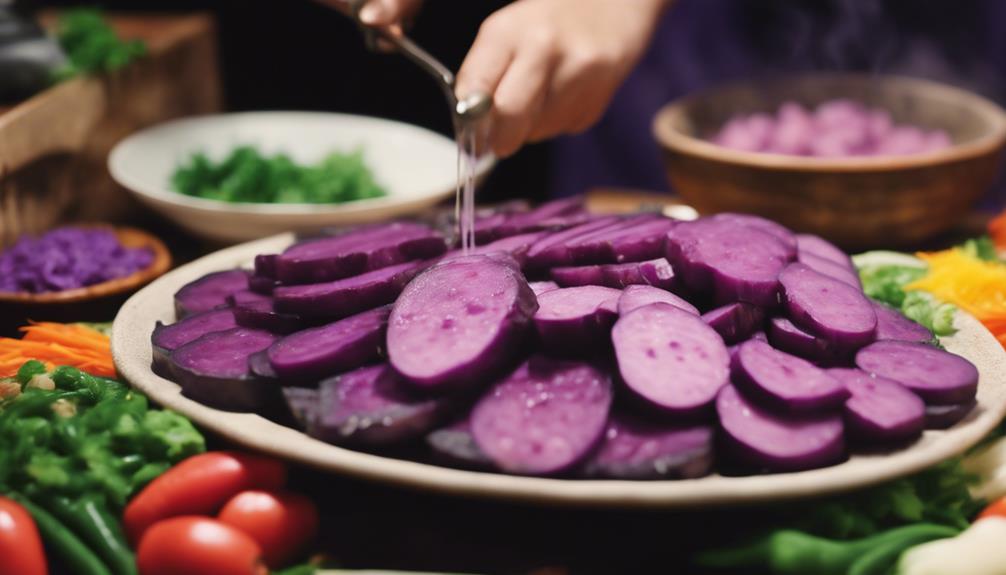
Consider incorporating the unique flavor and vibrant color of Okinawan sweet potatoes into your culinary creations for a delightful twist. These potatoes aren't your average spuds; they bring a pop of purple to your plate and a burst of sweetness to your taste buds.
Here are some fun facts and tips to get you started:
- Purple Power: Okinawan sweet potatoes boast a beautiful purple hue that can elevate the visual appeal of any dish.
- Nutrient Ninja: Packed with vitamins, fiber, and antioxidants, these potatoes offer both deliciousness and nutritional benefits.
- Versatile Veggie: From fries to pies, Okinawan sweet potatoes can be used in a variety of dishes to add a unique twist.
- Cooking Creativity: Try baking, roasting, or even mashing these spuds for a delightful culinary adventure.
Hearty Okinawan Stew
So, you've made it to the hearty Okinawan stew section – imagine this:
succulent Pork Belly and Daikon Stew,
savory Pork and Tofu Stir-Fry,
and comforting Seaweed and Pork Soup –
all waiting to tantalize your taste buds.
These dishes are the heart and soul of Okinawan cuisine, promising warmth and satisfaction in every spoonful.
Pork Belly and Daikon Stew
The Pork Belly and Daikon Stew, a comforting dish rich in flavors, is a staple in Okinawan cuisine. Imagine a hearty bowl filled with tender pork belly and daikon radish simmered to perfection in a savory broth – it's a hug in a bowl! Here's what makes this stew a must-try:
- Melt-in-your-mouth pork belly: Slow-cooked until it's so tender, it practically falls apart.
- Daikon radish: Adds a subtle sweetness and soaks up all the delicious flavors of the broth.
- Soy sauce and dashi: Creating a umami-packed base that will have you licking the bowl.
- Comfort in a bowl: Perfect for chilly nights or when you need a big, warm hug from your food.
Pork and Tofu Stir-Fry
When preparing the Pork and Tofu Stir-Fry, make sure your ingredients are prepped and ready for a quick and flavorful cooking experience. You're about to begin on a journey of sizzling goodness that will leave your taste buds doing a happy dance. Here's a quick guide to help you nail this pork and tofu masterpiece:
- Slice the pork and tofu into bite-sized pieces.
- Heat up your wok or skillet with a dash of oil.
- Throw in the pork and tofu, letting them move around until they're golden brown.
- Add your favorite stir-fry sauce and veggies, stir it all up, and voilà – you've got yourself a flavorful stir fry ready to impress your palate!
Seaweed and Pork Soup
Get ready to simmer a comforting pot of Seaweed and Pork Soup, a hearty Okinawan stew that will warm your soul with each spoonful. Imagine the savory aroma filling your kitchen as you prepare this delicious dish.
Here's what you'll need:
- Pork broth: A rich, flavorful base that will infuse your soup with meaty goodness.
- Seaweed salad: Adding a touch of the ocean's umami to elevate the flavors in your stew.
- Tender pork pieces: Cooked until they melt in your mouth, adding protein-packed goodness.
- Assorted vegetables: Carrots, daikon, and other veggies for a colorful and nutritious mix.
With these ingredients and a bit of simmering magic, you'll have a steaming bowl of Seaweed and Pork Soup that's sure to satisfy your cravings. Enjoy!
Enhancing Umami Flavors
So, you want to take your Okinawa Tonjiru to the next level by enhancing those savory umami flavors?
Well, get ready to discover the secrets of boosting umami with special ingredients, mastering cooking techniques that elevate taste, and finding that perfect balance for a flavor explosion in every bite.
Trust us, your taste buds are about to embark on an umami adventure like never before!
Umami-boosting Ingredients
To amplify the umami flavors in your Sous Vide Okinawa Tonjiru recipe, consider incorporating ingredients like bonito flakes, dried shiitake mushrooms, and kombu seaweed. These umami secrets are like the superheroes of flavor enhancers, swooping in to rescue your dish with their savory powers!
Bonito flakes bring a smoky depth, dried shiitake mushrooms add a rich earthiness, and kombu seaweed contributes a touch of the ocean's umami magic. Picture them coming together in your pot, creating a symphony of flavors that will make your taste buds dance with joy.
Cooking Techniques for Umami
Consider experimenting with different cooking techniques to maximize the umami flavors in your dish, elevating its taste to a whole new level. When using sous vide, you can extract maximum flavor from umami-rich ingredients, enhancing the umami depth of your dish. Check out the table below for some techniques that can help you achieve that perfect umami balance:
| Cooking Technique | Description | Benefits |
|---|---|---|
| Sous Vide | Cook food in a vacuum-sealed bag at precise temps | Intensifies flavors |
| Slow Braising | Low and slow cooking method for rich flavors | Develops deep umami |
| Fermentation | Enhances umami through natural fermentation | Adds complexity |
| Reduction | Concentrates flavors through simmering liquids | Boosts umami intensity |
| Maillard Reaction | Browning of proteins for savory taste | Adds depth of flavor |
Try these techniques to reveal the full potential of umami in your dishes!
Balancing Umami Flavors
Enhance the umami flavors in your dish by carefully balancing a combination of savory elements. When exploring umami, think of it as the secret weapon in your culinary arsenal – that mouthwatering, savory taste that keeps you coming back for more. Achieving flavor balance is like conducting a symphony; each ingredient has a role to play, from the rich miso to the earthy mushrooms.
Don't be afraid to experiment – sprinkle a dash of soy sauce here, a pinch of bonito flakes there. Taste as you go, adjusting the levels until you hit that perfect umami crescendo. Remember, it's all about finding harmony in your flavors, creating a dish that sings with depth and satisfaction.
Final Thoughts
To wrap up, reflect on your experience preparing this delicious Sous Vide Okinawa Tonjiru dish. Your culinary exploration into this recipe has been a flavorful journey full of surprises. From the savory umami notes of the pork to the vibrant mix of vegetables dancing in your mouth, every bite was a symphony of taste.
As you sipped the warm broth and felt the richness of the flavors envelop your senses, you couldn't help but marvel at how a simple dish could hold such complexity. Balancing those umami flavors was like conducting a delicious orchestra, ensuring each ingredient played its part perfectly.
In the end, whether you're a seasoned chef or a kitchen newbie, this Sous Vide Okinawa Tonjiru recipe has shown you that culinary adventures aren't just for the experts. So go ahead, keep experimenting, keep exploring, and most importantly, keep enjoying the delightful world of flavors that cooking has to offer. Cheers to your next flavorful escapade!
Frequently Asked Questions
Can This Recipe Be Adapted for a Vegetarian or Vegan Version?
Yes, you can adapt the recipe for a vegetarian or vegan version. Consider using vegetable broth or miso for flavor. Swap pork for tofu or seitan. Adjust cooking time accordingly. Experiment with different veggies like mushrooms and seaweed for a unique twist.
How Can I Adjust the Seasoning to Make It Less Salty?
To adjust the seasoning and make it less salty, try adding a bit of acid like lemon juice or vinegar to balance the flavors. You can also dilute the broth with water for a sodium reduction and gentle taste adjustment.
Are There Any Alternative Vegetables That Can Be Used in This Dish?
You can try using daikon, kale, or shiitake mushrooms as vegetable substitutes in the dish. Experiment with different flavor variations by adding miso paste or soy sauce. Adjust cooking techniques and recipe modifications to suit your taste preferences.
Can I Use a Different Type of Meat Instead of Pork?
Yes, you can use a different type of meat instead of pork in the recipe. Consider a beef alternative for a heartier flavor, a chicken substitution for a lighter touch, or even a lamb option for a unique twist. Seafood can also be a delicious swap.
Is It Possible to Make a Larger Batch and Freeze Portions for Later?
Yes, you can definitely make a larger batch of soup and freeze portions for later. It's a great idea for meal prep and long term storage. Enjoy the convenience of batch cooking and having delicious soup on hand!
Conclusion
So there you have it, folks! With just a little bit of time and patience, you can whip up a delicious and nutritious sous vide Okinawa tonjiru right in your own kitchen.
Just follow the simple steps, let the magic of sous vide do its thing, and voila – a hearty stew that will warm your soul and fill your belly.
So go ahead, give it a try and impress your friends and family with your newfound cooking skills! Bon appétit!
